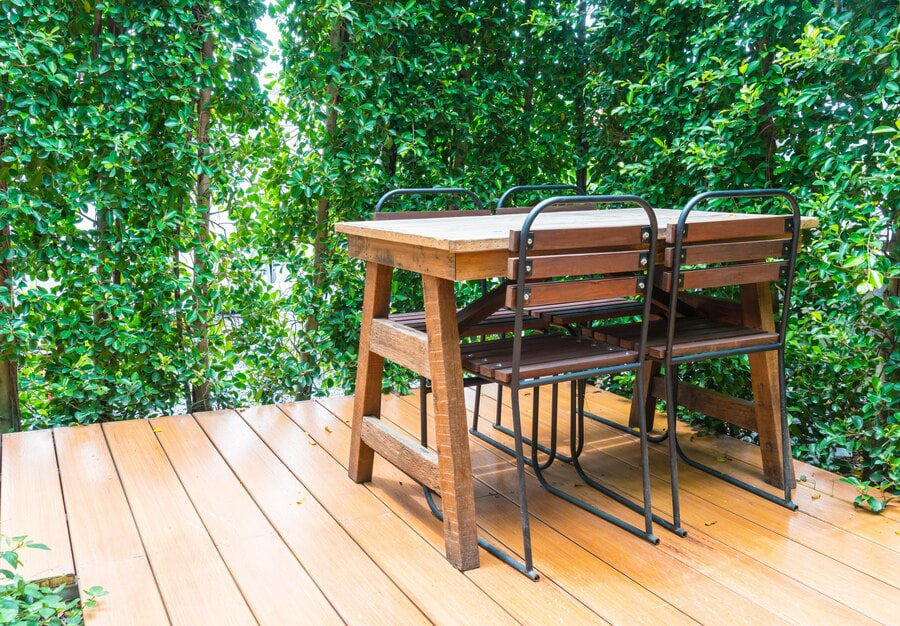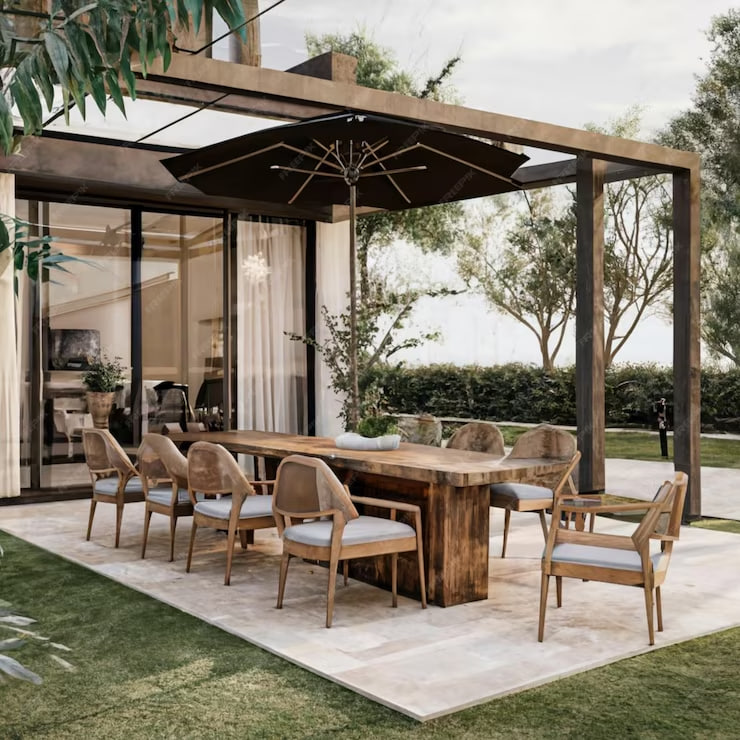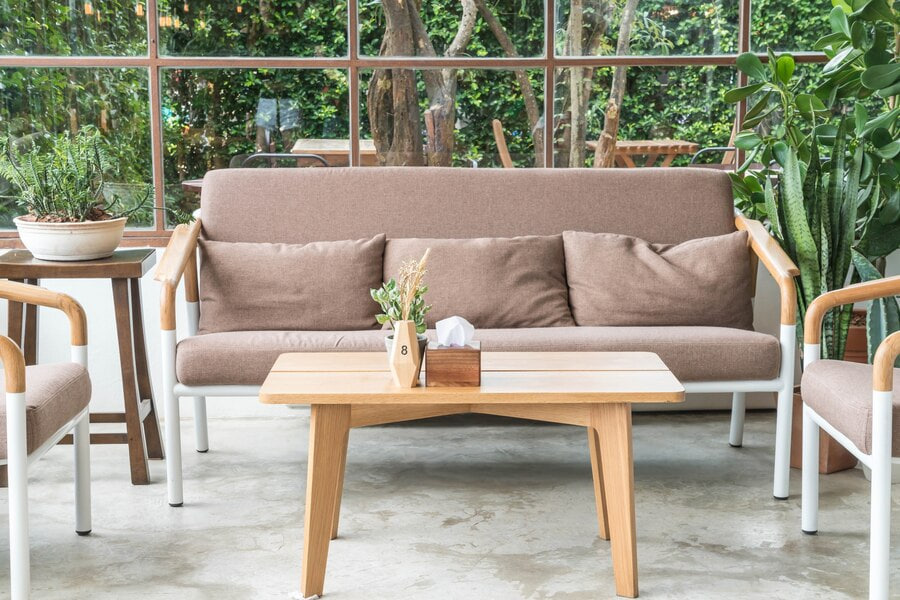10 Best Flooring for Porches
17 May, 2024
Porch flooring is one of the multiple things to consider when renovating an old house or constructing a new one. Today’s choice of flooring for porches is wider than ever: some options are highly durable, while others are more visually appealing or cost-effective.
Long story short, here are the top 10 big and small front porch flooring ideas to help you make a more informed choice.
Factors To Consider Before Selecting Porch Flooring
Your porch floor should meet your practical needs, aesthetic preferences, and environmental conditions. Here are some key factors to consider:
- Design. Ensure that your front porch flooring coordinates well with the exterior of your home, including the color of the walls, doors, and trim.
- Climate and weather. It’s essential to consider the local climate and the porch’s exposure to rain, snow, sun, and humidity, choosing the material that can withstand these conditions. Also, remember that some materials can get uncomfortably hot in direct sunlight.
- Traffic. Assess the level of foot traffic the porch will experience. If it’s a high-traffic area, go for a durable flooring material that is resistant to wear and tear.
- Ease of maintenance. Porches are prone to accumulating dirt, leaves, and other debris, so you might prefer a flooring option that is easy to clean.
Budget. Set a budget for your porch flooring project, taking into account both the cost of the materials and the installation.
10 Best Flooring Options for Porches
1. Hardwood
If you’re looking for the best flooring for a porch of a rustic house, solid-profile hardwood is an excellent choice. It’s remarkably durable and resistant to moisture. Hardwood can last decades if pressure-treated to minimize the risk of pest infestations and rot.
On the other hand, hardwood is one of the most expensive options. In addition, the material is challenging to work with, so you’ll likely need to hire an installation professional.
Also, check whether the lumber you want to buy is certified by the FSC, meaning it has been harvested from sustainable sources.
2. Natural Stone
It’s safe to say that the classic-looking natural stone is the most durable porch surface — it can last for a century or more. Natural stone is innately warp-free and resistant to moisture and temperature fluctuations, ensuring your porch remains structurally sound and visually appealing throughout the year.
The cost depends on the type of stone and ranges between $2 (granite) and $75 (quartz) per square foot, making it suitable for various budgets.
On the downside, natural stone becomes slippery and unsafe when wet.

3. Composite Decking
Composite is made from recycled plastic mixed with wood fibers. While looking like natural wood, composite is resistant to rot, mold, pest infestations, and stains and can last for decades.
An affordable alternative to traditional wood deck boards, composite tiles are a particularly low-maintenance option: they don’t require refinishing like wood and are easy to clean. One disadvantage of composite decking is that it’s more susceptible to UV fading than other types of flooring.
4. Rubber
Rubber porch flooring can be your way to go if you put safety and comfort first. Rubber is slip-resistant, making it an excellent choice for places with frequent rains. In addition, it boasts outstanding shock-absorbing properties, minimizing impacts from falls and being super comfortable to stand and walk on.
Moreover, rubber is a pretty low-maintenance choice: it doesn’t require coating and is a no-brainer to clean. On the downside, rubber is prone to discoloration and can harden over time when exposed to extreme temperatures.
5. Vinyl
Vinyl flooring is made of hollow PVC boards with a ribbed internal structure for extra strength. Like other synthetic materials, vinyl is resistant to rot, stains, pests, and mold. It’s easy to clean and relatively inexpensive.
However, vinyl can fade over time when exposed to direct sunlight. In addition, it can get hot in high temperatures, making it not the most suitable flooring for porches in hot climates. To top it off, outdoor vinyl flooring can only last up to 20 years.
6. Brick
Brick is undoubtedly one of the most charming front porch flooring options. Moreover, brick pavers boast exceptional strength and durability. Brick withstands extreme temperatures and is immune to pests and rot. Even if damage occurs, you can replace individual pavers to maintain a flawless look of your porch.
On the other hand, installing brick pavers is a tedious job that requires time and patience, directly affecting installation costs. In shaded or damp areas, bricks may develop moss or mildew, requiring periodic cleaning to maintain their appearance.
7. Ceramic

Ceramic tiles are available in an exciting range of colors, patterns, and designs, allowing for creative customization to match your outdoor style. High-quality tiles are durable enough to withstand heavy foot traffic and relatively easy to clean and maintain. In addition, ceramic tiles tend to stay cool in hot weather, providing a comfortable surface to walk on.
On the downside, they’re crack-prone. Also, the grout lines require periodic maintenance to prevent staining and mildew growth.
8. Concrete
The low cost of the material and easy installation make concrete flooring the most affordable option. In addition, concrete is durable, water-resistant, and immune to rot and pests. Concrete flooring is also pretty versatile — it can match various styles, from traditional to contemporary.
However, concrete is likely to crack in areas with extreme temperature fluctuations. Plus, it can get extremely hot in hot weather. Lastly, concrete often becomes slippery when wet, creating safety hazards.
9. Porcelain

Porcelain is similar to ceramic — both are produced from a clay mixture fired in a kiln. However, porcelain is fired at higher temperatures, which makes it more durable and harder. Porcelain is scratch-resistant and easy to clean.
On the other hand, porcelain is more expensive than other materials. Also, while known for its durability, it isn’t wholly immune to chipping or cracking, especially if heavy objects are dropped on it. In addition, grout lines between porcelain tiles may require periodic deep cleaning and sealing to maintain their appearance.
10. Laminate
While laminate flooring is a great choice for indoor areas, it isn’t the best flooring for an outdoor porch. Although laminate may have a higher level of water resistance, it can be damaged by extreme temperatures and direct sunlight and won’t last very long.
Given that, laminate flooring is only suitable for a well-covered porch.
Maintenance Tips and Considerations
Maintaining porch flooring is essential to ensure its longevity, safety, and visual appeal. While maintenance specifications can vary depending on the material, some general maintenance measures apply to various types of porch flooring.
- Sweep or vacuum the porch regularly to remove dirt, leaves, and debris.
- Clean spills immediately to prevent stains, especially on porous materials.
- Use a mild soap or a manufacturer-approved cleaning solution for washing the floor.
- Do not use abrasive brushes or metal tools that may scratch or damage the surface.
- Follow the manufacturer’s recommendations for sealing or coating the porch floor to protect against moisture, UV rays, and other environmental factors.
- Keep gutters clean and ensure proper drainage away from the porch to prevent water damage.
- Always refer to the manufacturer’s care and maintenance guidelines specific to the type of flooring material used.
